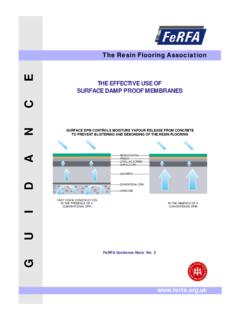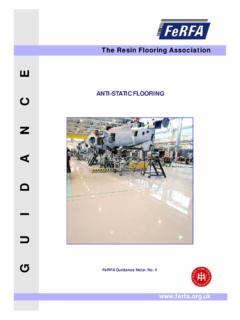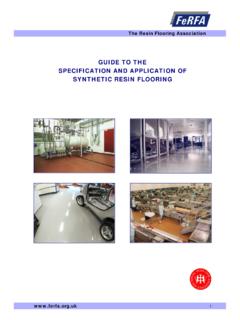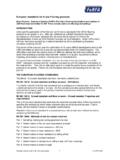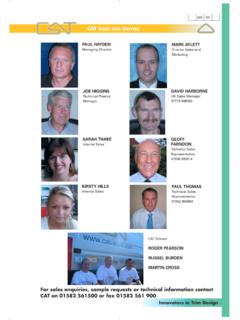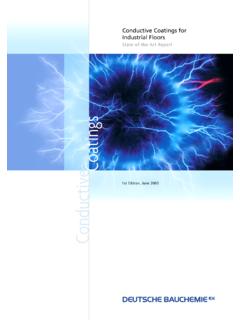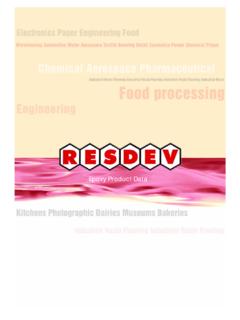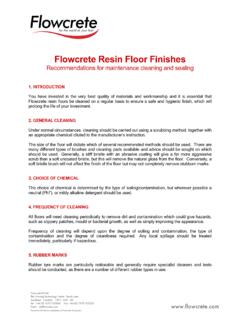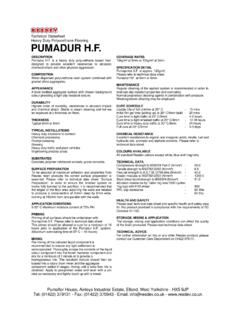Transcription of FeRFA GUIDE TO CLEANING RESIN FLOORS - NIFL
1 The RESIN Flooring Association 1 FeRFA GUIDE TO CLEANING RESIN FLOORS The RESIN Flooring Association 2 CONTENTS 1. 2. General 3. TYPICAL CLEANING Scrubbing Manual - Mop and floor Vacuum Scrubber Pressure Washers Or Steam CLEANING 4. ANTI-STATIC 5. CLEANING General CLEANING 6. WASTE 7. 8. 9. TYPES OF RESIN FLOORING AND CLEANING 10. GENERAL TIPS & Information on FeRFA Associate List of FeRFA FeRFA FeRFA , the RESIN Flooring Association represents RESIN flooring product manufacturers, specialist contractors and allied trades. Established in 1969, FeRFA now represents over 60 UK based companies. The Association has established Codes of Practice for full members. It takes an active role in promoting RESIN flooring and in developing both national and international standards. All FeRFA publications are freely downloadable from the website at for further information, contact FeRFA at: 16 Edward Road, Farnham, Surrey, GU9 8NP T: 01252 714250 W: Although care has been taken to ensure, to the best of our knowledge, that all data and information contained herein is accurate to the extent that it relates to either matters of fact or accepted practice or matters of opinion at the time of publication, FeRFA assumes no responsibility for any errors in or misrepresentation of such data and/or information or any loss or damage arising from or related to its use.
2 All rights reserved. No part of this publication may be reproduced, stored in a retrieval system or transmitted, in any form or by any means, electronic, mechanical, recording or otherwise, without prior permission of FeRFA . ISBN: 0 9538020 9 4 FeRFA ( RESIN Flooring Association) 2006 The RESIN Flooring Association 3 1. INTRODUCTION A variety of different types of synthetic RESIN systems are available which can form the binder of a flooring system. These include typically epoxy, polyurethane and methacrylate resins. RESIN flooring systems are used in a wide variety of situations, for each particular situation there is an optimal specification which takes into account the required performance parameters. The new BS 8204-6 (following the FeRFA GUIDE ) states in section that: "It is essential that, in the design and construction stages, there should be full consultation with the end user and contractor and manufacturer of the synthetic RESIN flooring to ensure that the product to be selected is entirely suited for the conditions both during application and in subsequent service".
3 (refer to FeRFA Selection GUIDE for Synthetic Flooring) RESIN FLOORS are tough resilient systems, however, for the performance characteristics of the floor to be maintained, an appropriate CLEANING regime should be agreed in advance. The CLEANING regime will itself be determined by a number of factors, the type of RESIN flooring installed, the type and frequency of traffic, the degree and type of soiling and specific hygiene requirements. 2. CLEANING Flooring CLEANING can be thought of as having two components, a mechanical component and chemical component, these two components should work together to mutual advantage. The mechanical component energy may be applied to the floor by hand with a scrubbing motion. Usually the input is by mechanical agitation, a floor scrubber. High energy inputs may also be achieved by using high pressure washers, hot water washers and steam cleaners. The chemical component, CLEANING solution , will dissolve or emulsify the type of soil or contamination present.
4 Once this has taken place the removal of the dirty water and rinsing of the floor are key to successful CLEANING . It is important that clean water is used for rinsing. RESIN flooring will not be affected by most generally available special purpose CLEANING materials, when these are used in accordance with the Chemical CLEANING manufacturers instructions and the floor rinsed properly with clean water. A small spot test in an inconspicuous area is a worthwhile precaution before applying any new CLEANING product. The CLEANING regime should specify the type of equipment to be used, the type of CLEANING chemicals to be used and the frequency of the CLEANING . Each CLEANING regime will be specific for a particular set of conditions. Should any of the factors vary the type of soiling, then a change in the CLEANING chemicals may be required. In order that the floor continues to provide the intended performance and meets the hygiene requirements, then it is essential that the user implements the appropriate CLEANING regime General CLEANING RESIN FLOORS will not dust.
5 However, dust will settle on the floor from other sources ( dusty beams above, blown from outside, from processes, brought in on goods). FLOORS which are kept clean will last longer. Fine particles of dust, dirt, debris, act as abrasives with traffic unless the floor is cleaned regularly. For the pharmaceutical, cosmetic and food industries it is particularly important to maintain hygienic surfaces, proper CLEANING techniques are essential. In engineering works, metal swarf is particularly abrasive and if not removed from the floor , can cause damage in a short space of time. The RESIN Flooring Association 4 Thus, to maintain a clean, safe and healthy environment, proper management is required including suitable CLEANING /vacuum removal and dust control systems ( mats), in addition to routine manual/mechanical sweeping as required. 3. TYPICAL CLEANING METHODS Scrubbing Manual - Mechanical Sweep floor to remove loose debris and accumulations of soil.
6 Use the appropriate CLEANING agent - detergent, deodorizer, degreaser, emulsifier. Apply CLEANING agent diluted as required and allow it to react on surface. - Agitate by hand using a stiff brush or mechanically. Flood with clean water and scrub. Remove dirty water with wet vacuum or squeegee to floor drains. Contaminated water may be required to be disposed of as hazardous waste. Observe all regulations, which prohibit introduction of certain chemical cleaners, solvents and wastes into surface water drains, sewer systems, open bodies of water or into the soil. Rinse again and remove. Regular washing with a suitable washer/drier machine should normally be carried out using a low foam neutral detergent. Note: The use of brushes in certain situations may be more effective than the use of pads, however care should be taken by the operator to raise abrasive pads or brushes off the floor when stationary since permanent ring marks may result when the machine stops in one position.
7 Mop and Bucket Over 300,000 cleaners daily in the UK still use the mop and bucket. This should be the CLEANING method for dealing with spillages, but is not for routinely CLEANING the floor . In normal every day usage the mop and bucket may remove heavy soiling but typically the water is changed infrequently with the result that the floor is usually wiped with dirty water and a film of dirt spread uniformly across the floor . floor Scrubber This is the preferred method for CLEANING RESIN FLOORS , to ensure: Controlled application of CLEANING agent Effective scrubbing action Continuous supply of clean water Continuous removal of dirty water Continuous drying of the floor The choice of using brushes or pads will usually be determined by the profile of the floor and the degree of soiling. Brushes are normally better on FLOORS with raised non slip finish, and FLOORS with a significant texture. The RESIN Flooring Association 5 A wide range of pads are available for specific tasks.
8 BLACK Heavy duty stripping, quickly removes dirt, wax, floor finish and sealers. For use with any stripping agent. GREEN Light stripping and wet scrubbing. Thoroughly removes dirt and scuff marks. BLUE Wet scrubbing or heavy duty spray CLEANING . Gives the floor a thorough scrubbing removing dirt and scuffs. Will remove top of surface finish ready for re-coating. RED Use for smooth shiny finish whilst removing light dirt. The typical spray CLEANING /buffing pad. TAN Dry polishing/buffing pad. Removes light dirt whilst shining FLOORS . Especially good in light traffic areas. WHITE Supreme fine pad for polishing dry FLOORS . Use with soft finishes for superior polish. Excellent on softly waxed FLOORS . Produces high gloss finish. Also suitable as ultra high speed CLEANING pad with exceptional dimensional stability for use with ultra high speed machines. Will remove light dirt whilst maintaining high gloss finish Vacuum Scrubber Driers Sweep floor to remove loose debris and accumulations of soil.
9 Use the appropriate CLEANING agent - detergent, deodorizer, degreaser, emulsifier, etc., or combination of agents. Apply CLEANING agent (or combination of agents) diluted as required in the on board detergent tank and allow it to react on surface. Agitate by mechanically using the floor scrubber. Remove dirty water with wet vacuum. Observe all regulations, which prohibit introduction of certain chemical cleaners, solvents and wastes into surface water drains, sewer systems, open bodies of water or into the soil. Rinse and scrub again and vacuum clean and dry. Pressure Washers Or Steam CLEANING Equipment Care should be taken to select suitable equipment. These pieces of equipment can be extremely powerful, proper training should be given to ensure they are used safely. Sweep floor to remove loose debris and accumulations of soil. Pre-wet floor . Use the appropriate CLEANING agent - detergent, deodorizer, degreaser, emulsifier, bactericide.
10 Steam cleaners may require special CLEANING agents. Apply CLEANING agent (or combination of agents) diluted as required and allow it to react on surface. Using the pressure washer or steam cleaner, work the entire surface of the floor in a planned sequence. This will agitate and loosen hard-to-remove soil or contamination. Flood with clean water and work over the floor surface once again. For food processing areas reference should be made to the recommendations of CCFRA, (Camden and Chorley Wood Food Research Association) Other areas subject to special CLEANING regimes are anti-static flooring, clinical FLOORS , nuclear facilities. Observe all regulations, which prohibit introduction of certain chemical cleaners, solvents and wastes into surface water drains, sewer systems, open bodies of water or into the soil. Rinse again and remove. It should be clearly understood, particularly when steam CLEANING , that it is advisable always to check with the contractor/manufacturer as to the suitability of the floor for constant steam CLEANING Heavy Duty Polyurethane Flooring at 9mm ( FeRFA Type 8) is a system designed to withstand steam CLEANING .
